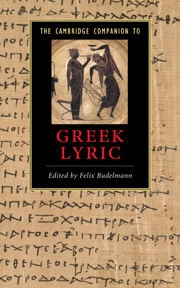Book contents
- Frontmatter
- Introducing Greek lyric
- Part I: Contexts and topics
- Part II: Poets and traditions
- 8 Iambos
- 9 Elegy: Forms, functions and communication
- 10 Alcman, Stesichorus and Ibycus
- 11 Alcaeus and Sappho
- 12 Anacreon and the Anacreontea
- 13 Simonides, Pindar and Bacchylides
- 14 Ancient Greek popular song
- 15 Timotheus the New Musician
- Part III: Reception
- Chronology of select melic, elegiac and iambic poets
- Further Reading
- Glossary
- List of works cited
- Index
11 - Alcaeus and Sappho
from Part II: - Poets and traditions
Published online by Cambridge University Press: 28 May 2010
- Frontmatter
- Introducing Greek lyric
- Part I: Contexts and topics
- Part II: Poets and traditions
- 8 Iambos
- 9 Elegy: Forms, functions and communication
- 10 Alcman, Stesichorus and Ibycus
- 11 Alcaeus and Sappho
- 12 Anacreon and the Anacreontea
- 13 Simonides, Pindar and Bacchylides
- 14 Ancient Greek popular song
- 15 Timotheus the New Musician
- Part III: Reception
- Chronology of select melic, elegiac and iambic poets
- Further Reading
- Glossary
- List of works cited
- Index
Summary
In a letter of 25 July 1907 to his wife, Rainer Maria Rilke drew a connection between an ancient dialogic song associated with Alcaeus and Sappho and an early fifth-century red-figure vase depicting the two Lesbian poets. Rilke writes: ‘Alcaeus was a poet, who on an antique vase stands before Sappho with head lowered and lyre in hand, and one knows that he has said to her: “Weaver of darkness, Sappho, you pure one with the honey-sweet smile, words throng to my lips, but shame holds me back”’. The song that Rilke quotes is a conflation of (a version of) Alcaeus fragment 384 V and Sappho fragment 137 V, while the kalathoid vase he has in mind depicts (on its obverse) two musicians, with their names, Sappho and Alcaeus, inscribed next to their figures (Fig. 5). Holding – or having just struck the strings of – his barbitos, Alcaeus is shown singing. The string of vowels that come out of his mouth do not disclose what he is singing about, but modern scholars – and Rilke – have seen in the lowered position of his head an indication of αἰδώς (‘shame’), thus connecting the image on the vase with the dialogic song between Sappho and Alcaeus that Aristotle quotes in his Rhetoric 1367a – a (fragmentary) song attributed by a number of editors to Sappho (137 V).
- Type
- Chapter
- Information
- The Cambridge Companion to Greek Lyric , pp. 204 - 226Publisher: Cambridge University PressPrint publication year: 2009
- 9
- Cited by

